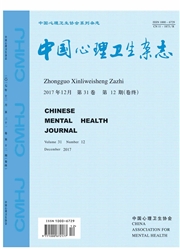

 中文摘要:
中文摘要:
目的:探讨随刺激呈现次数的增加,高焦虑个体对威胁性刺激注意偏向的变化。方法:被试为大一新生,依据状态一特质焦虑问卷得分,随机选择了得分最高的25%部分中的24人作为高焦虑组,得分最低的25%部分中的23人作为低焦虑组。实验采用点探测视觉搜索任务,以威胁性词语为刺激材料,刺激呈现8次,分析刺激每次呈现时高低焦虑组被试对威胁性词语的注意偏向。结果:当刺激首次呈现时只有高焦虑组被试的注意偏向值与0相之间差异有显著性(t=2.34,P〈0.05)。方差分析显示在刺激呈现的前三次,随着刺激呈现次数的增加,只有高焦虑组被试的注意偏向值发生了显著的变化(F=5.44,P〈0.01.注意偏向值分别为:13.1±27.3,2.5±27.0,-10.0±27.9),对刺激呈现的后五次高低焦虑组个体的注意偏向值变化均不显著。结论:随着词语刺激呈现次数的增加,高焦虑被试对威胁性词语的注意偏向表现出习惯化倾向。
 英文摘要:
英文摘要:
Objective: This study aimed to investigate the pattern of anxiety-related attentional bias for threatening words in subjects with high- and low-trait anxiety by repeating the occasions of stimulus exposures. Methods: High (upper 25% ) and low (lower 25% ) anxious individuals (N = 24 and N = 23 respectively) participated in a forcedchoice reaction time version of a modified dot-probe task. There were 48 negative-neutral word pairs chosen as stimuli. Each word pairs were presented eight occasions in different blocks, and at each occasion the attentional bias to the emotionally negative word was examined. Results: High anxious individuals showed initial selective attention to the negative words when they were presented for the first occasion ( t = 2. 34, P 〈 0. 05 ) . However, the pattern of attentional bias changed from initial vigilance to the trend of avoidance when stimulus were presented in the second and third occasions ( F = 5.44, P 〈 0.01 ; the bias were 13. 1 ± 27.3, 2. 5 ± 27.0, - 10. 0 ± 27.9 respectively) ; after then no attentional bias towards the negative word meaning was observed. Conclusion: After initial attentional bias to threatening words, high anxious participants showed habituation to these words when they were presented more exposures.
 同期刊论文项目
同期刊论文项目
 同项目期刊论文
同项目期刊论文
 期刊信息
期刊信息
